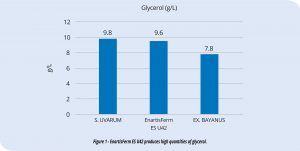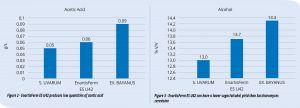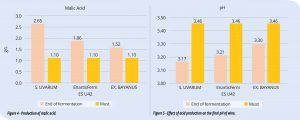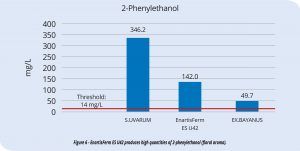Enartis News – EnartisFerm ES U42: the art of Amarone winemaking for all types of wine
EnartisFerm ES U42 is a yeast blend consisting of a cryophilic strain of Saccharomyces uvarum species and a strain of Saccharomyces cerevisiae ex ph. r. bayanus, modelled on a spontaneous fermentation of Amarone.
Amarone della Valpolicella is a dry wine made from grapes harvested in September/October and dried in the cellar until late winter.
Therefore, crush and fermentation take place during colder months and, according to tradition, without the use of heating systems. Microbiological studies have shown that the spontaneous fermentation of Amarone is the result of a rotation of different species of yeasts: the first to ferment are strains of the cryophilic species Saccharomyces uvarum, followed by strains of Saccharomyces cerevisiae, more tolerant to ethanol, but less active at low temperatures (Table 1).

Hence, the idea of proposing a Saccharomyces uvarum – Saccharomyces cerevisiae blend that produces wines with some traits that characterize Amarone:
- high glycerol content;
- low volatile acidity;
- maintenance of total acidity;
- intense fruity/floral aroma.
FERMENTATION TESTS
The following are the main enological characteristics that were found by comparing the performance of EnartisFerm ES U42 with the individual species that
make it up:
- S. UVARUM (Saccharomyces uvarum).
- EX. BAYANUS (strain of the species Saccharomyces cerevisiae, ex ph. r. bayanus).
High Production of Glycerol
The high production of glycerol (Figure 1), makes EnartisFerm ES U42 particularly interesting for the production of wines with a high alcohol potential.
Glycerol reduces the burning sensation of alcohol, and softens astringency of higher tannin wines.

Low Volatile Acidity
The chemical analysis carried out during and at the end of alcoholic fermentation shows extremely low volatile acidity production (Figure 2) in relation to the
final alcohol content (Figure 3).

Maintaining Total Acidity
Wines produced with EnartisFerm ES U42 retain good acidity partly due to the production of moderate quantities of succinic acid and partly to the production of malic acid (Figure 4). This also contributes to maintaining a lower pH (Figure 5).

Increase in Intensity and Aromatic Complexity
Another aspect that characterizes EnartisFerm ES U42 is the ability to produce 2-phenylethanol, an aromatic compound responsible for the hint of rose (Figure 6), in quantities that increase aromatic complexity and enhance fruity notes without masking varietal character.

Conclusions
Yeast of the Saccharomyces uvarum species have very interesting enological properties – production of high quantities of glycerol, low quantities of volatile acidity and maintenance of total acidity – but also some shortcomings such as low alcohol tolerance and some overexpressed characters such as the excessive production of 2-phenylethanol and succinic acid that could overshadow other qualities of a wine. By reproducing what naturally occurs in the fermentation of Amarone, one of the greatest Italian red wines, the creation of a balanced blend of Saccharomyces cerevisiae, ex r.f. bayanus maintains the
positive characteristics of the Saccharomyces uvarum species and compensates for any deficiencies.
This is how EnartisFerm ES U42 was created, an expression of the most interesting characters of the two species of which it is composed:
- High production of glycerol
- Low production of volatile acidity
- High alcohol tolerance
- In some cases, low alcohol yield
- Good production of organic acids
- High production of 2-phenylethanol (rose aroma)
RECOMMENDED APPLICATIONS OF ENARTISFERM ES U42
- Vinification of white, red and rosé wines
- Production of wines made from dried grapes
- Production of wines with intense floral aromas
- Production of wines which are soft on the palate with good volume
- Maintain/increase acidity
- Potential reduction in alcohol yield Stay